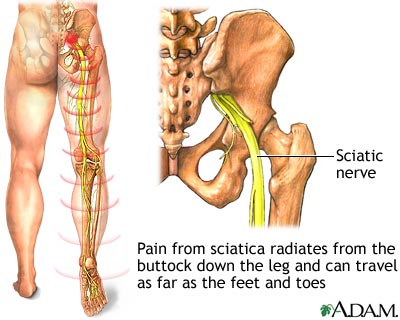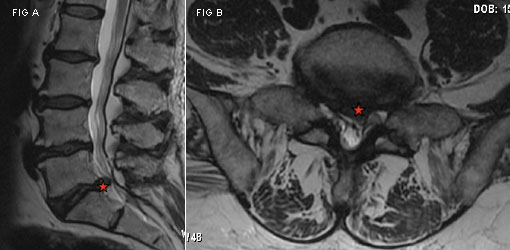Sciatica
Breakthrough, Specific and Proven Treatment advice
that can end your Sciatica Pain…Starting Today!



WHAT IS SCIATICA?
It is an irritation or compression of the sciatic nerve. The symptoms, since you are reading this, are probably something you intimately understand and you could describe yourself very well…
- Low back pain that radiates into the buttock
- Lancinating thigh and leg pain-from the buttock down to the
calf and possibly into the foot. - May or may not involve the back of the thigh.
- Leg/foot numbness
- Leg/foot pins and needles
- Burning pain and hyper sensitivity on the skin
- Cramping in the thigh, leg or foot
- Weakness of muscles in the thigh, leg or foot
- Foot drop- causes unusual tripping
- Decreased hamstring flexibility
There are more to this list, but that’s a good start; Now let’s look at
the sciatic nerve closer.
THE SCIATIC NERVE
The sciatic nerve starts at the spine and has a contribution from 5 different nerve roots. These nerve roots, after leaving the spine from 5 different locations, come together in the deep buttocks (close to a muscle we call the piriformis muscle) to form one thick nerve bundle…we call this bundle of nerves, the sciatic nerve.
Symptoms vary from person to person because injuries or conditions can affect one or more of these 5 nerves that go to different parts of the buttock, thigh, leg and foot.
REMEMBER: each nerve has a sensory portion for skin sensation, pain, and muscle feedback. There is also a motor portion for muscle control and strength. This adds to the complex nature of diagnosing sciatica.
WHAT REALLY IS SCIATIC NERVE PAIN?
Irritation or compression to the sciatic nerve occurs most commonly at either the place where the nerve root exits the spine or where the nerve bundle forms close to the piriformis muscle.
Remember that there are 5 contributions to the sciatic nerve, so irritation or compression can occur at any of the 5 different levels.
The most common reason for one of these 5 nerves to get pinched, especially for people between the ages of 20-65, is an injury to the intervertebral disc.
- Your disc has an outer portion that is fibrous and tough (the “annular fibrosus”) and a jelly filled interior (the “nucleus pulposus”), that acts as a cushion. Sort of like a jelly donut but with a tougher outer portion.
- Your discs can be injured in a number of ways to cause one of the contributing nerve roots to the sciatic nerve to become irritated or pinched, causing pain and all the grief that goes with it…
- The disc can bulge or protrude. Similar to a balloon that is squished but does not pop, the balloon or disc is pushed into the nerve root, but the jelly doesn’t squish out, it just migrates in the direction of the protrusion or bulge.
- The most common type of injury (and the one depicted in the image below) is a disc herniation. The jelly (seen in blue below) actually leaks out of the disc, severely irritating the nerve root and impacting the sciatic nerve.
- The third type of disc injury is degenerative disc disease — a deterioration of the disc due to dehydration and advanced wear and tear. These discs are associated with disc desiccation and can irritate the nerves leading to sciatica because as the disc shrinks in height, it diminishes the size of the hole the nerve exits… Squishing the nerve as it leaves.
- Piriformis syndrome – The other common reason for Sciatic nerve pain – is not located at the spine where the nerve root exits, but at the place where the nerves come together as a bundle to form the actual sciatic nerve. Sometimes the piriformis muscle can chronically go into spasm, pinching the sciatic nerve as it travels by or in rare cases through the muscle. (By the way, this is what I had when I had my problem; I figured it out through self study, not from the many medical doctors, chiropractors and physical therapists I saw.)
HOW DO WE FIGURE THE REAL CAUSE OF SCIATICA
Here is a hint… an x-ray will not tell you what the problem is. You need two different things to know exactly what the problem is…
One- A thorough examination from your low back all the way to your toes. It’s important that this examination is done by a spine and sciatica expert that tests both sensory and motor function of the lower body and legs. Evaluation of the muscles, including the glutes and piriformis, will quickly let you know whether you are dealing with a piriformis syndrome or something more serious. (I perform all patient evaluations myself because this examination is the most important step in helping someone end their pain.)
Two- a recent MRI. An MRI is the only way to see if there is a disc injury and if there is, the type of disc injury that someone has. This will allow a proper diagnosis and enable the design of a treatment program that will be EFFECTIVE for treating the problem, not just mask the symptoms. We require an MRI on all of our patients and we will help you get one if necessary. I read all MRI’s thoroughly to help make my clinical decision on your case. The MRI will not only show us the injury but it also shows you the state of the spinal muscles.
NOTE: When the disc injury pinches the nerve that affects your leg, something else happens! There is a branch of that nerve that does not go down the leg, but rather will go to the muscles behind the spine. The most affected muscle is called the Multifidus muscle. This muscle stabilizes the spine and buffers the pressure on your low back discs. The compromised nerve supply to the multifidus muscle allows the muscle to atrophy and undergo fatty, fibrous infiltration. Said another way, the muscle wastes away and the area where the muscle was turns to fat. Look at figure (B): the red star shows the herniation. If you look at the muscles below it on either side of the spine you see two very marbled looking steaks on either side of the spine. The white is fat; it should be dark!? Healthy muscles should look like two filet mignon; dark and muscular.
So, you can see that over time, in fact as short as one month, a problem involving your low back disc giving you sciatica will quickly start to affect the muscles and stability of the area. This becomes part of the problem and increases the chance that it will become chronic. So what is a person, whose life sucks because of severe sciatic pain, to do? (Keep reading for the answer!)
TREATMENTS THAT MASK THE CONDITION
I think that the answer, because of your newly learned information, should be obvious. Treatments that will only mask the problem but won’t rid you of this unrelenting condition are described in summary as:
Any treatment that does not partially or completely remove the disc injury.
Any treatment that does not address the weakness in the spinal muscles and leg as well as the functional loss due to muscle imbalance.
Treatments that DO NOT accomplish either one of these goals…
- Anti-inflammatories (decreases inflammation only)
- Muscle relaxants (does not address the cause)
- Pain medication (Masks the pain)
- Cortisone shots (decreases inflammation only)
- Epidural shots (removes inflammation only, does not change the disc injury)
- Chiropractic Care (does not change the disc or address weakness. Addresses muscles and joints only.)
- Physical therapy (does not address the disc, deals only with muscles)
- Some of these can help with pain management and may be included in a more comprehensive program that ends your suffering, but these treatments in and of themselves will not eliminate the underlying cause of your Sciatica.
SCIATICA TREATMENT
Then What Treatments Get to the Root of the Problem?
Remember the Goals of Treatment:
- A treatment that actually makes changes within and heals the disc itself.
- A treatment program that addresses muscle weakness and instability. Yes, the condition shown above with the fat replacing the weakened and wasted muscle is reversible!
Well, surgery addresses the first goal but unfortunately it commonly INCREASES the problems associated with the second goal; by cutting through muscle, bone and ligament it further destabilizes the injured area.
Advanced Spinal Rehabilitation has designed the ultimate Non-Surgical Sciatica treatment and rehabilitation program!
It accomplishes both goals of effective treatment by:
Using a therapy system called the DRX Decompression therapy system that addresses the disc injury. To learn more, go to our “What is DRX Decompression”area for a detailed explanation and look at the research after you read the rest of this important information….you are not going to want to miss the rest!
Providing a comprehensive strengthening, muscle re-balancing, chiropractic and rehabilitation program. Time and time again, we have found with close to 1,000 patients effectively treated, that a complete, comprehensive approach to care renders the greatest benefits.
I hope that this information has been informative and has revealed many things which will put you on the road to living a pain-free life once again.
You now know more than 90% of others who suffer with Sciatica!
Here’s what you know:
- You know that but does not tell you what is causing your problem or how to get rid of it.
- You know that with a thorough examination by a Sciatica Expert along with a Low back MRI, you can establish what is the true cause of your pain.
- You know what treatments only mask the pain but don’t actually treat the cause of your condition.
- You know that there are only a couple of effective treatments available for sciatica, one of which (surgery) is risky, has potentially a worse outcome and may further weaken the low back area.
- You know that low back weakness and muscle imbalance contribute to the chronic nature of your condition and if repaired is the key to preventing future episodes.
- You know that Advanced Spinal Rehabilitation is a Sciatica Expert that our doctors know as much as they can about sciatica and low back rehabilitation. Our goals is to end the pain for people just like you!
- You know that Advanced Spinal Rehabilitation understand this condition and offer a non-surgical answer to your complicated and painful problem.
What you may not know yet is why you have Sciatica or if you qualify for my revolutionary Sciatica Program. After your consultation and examination, YOU WILL!
Don’t guess any longer; get the facts, know the true cause of your sciatic nerve pain… take control, take the next step!
Here you can create the content that will be used within the module.
